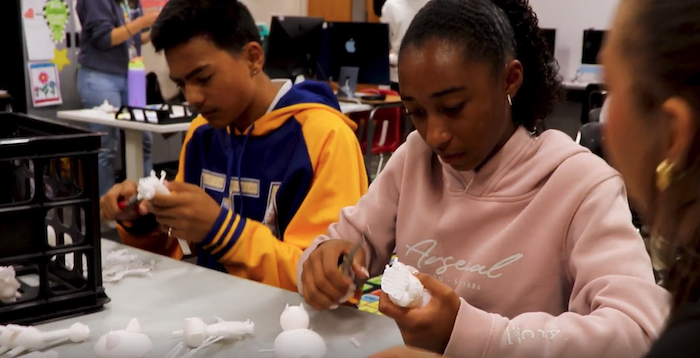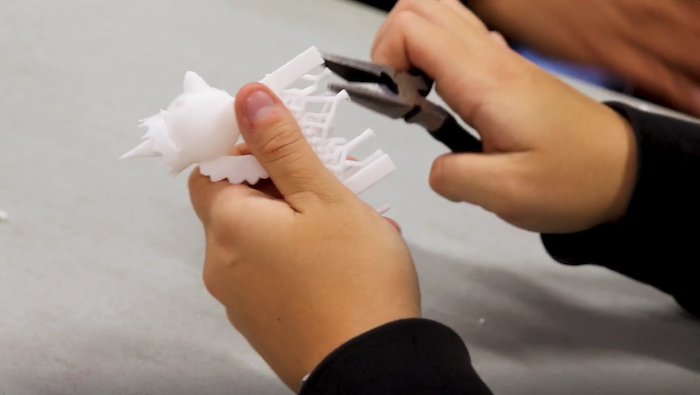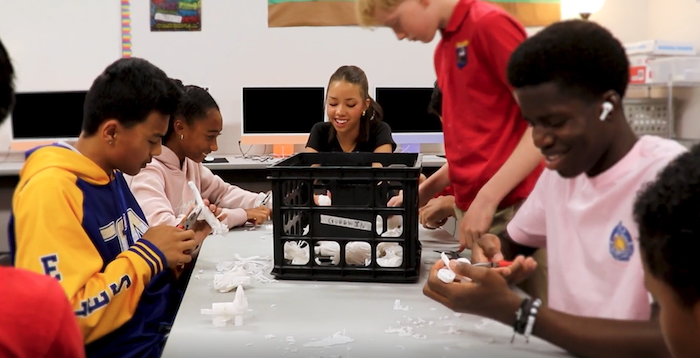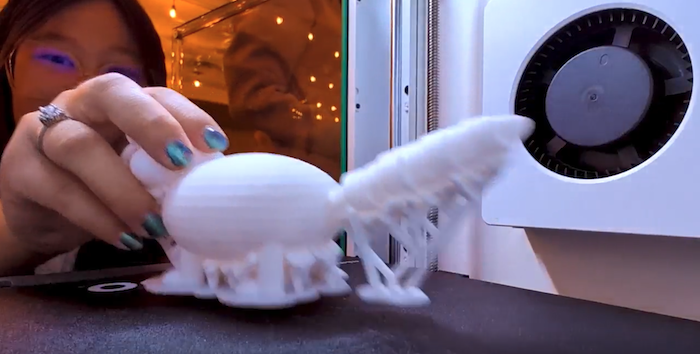Learn more about Cherry Creek Academy’s 3D printing journey here.
Excitement filled the room as kindergartners at Cherry Creek Academy received 3D-printed versions of the animals they had drawn weeks earlier. Designed by eighth graders and built on 3D printers, the small plastic figures were met with wide eyes and big smiles; what started as simple sketches had become tangible keepsakes that the Denver-area school’s youngest students could proudly call their own.
The project blended creativity, collaboration and hands-on learning. Using Tinkercad and Robo 3D printers from Boxlight, eighth graders took on the challenge of turning flat artwork into fully formed objects, an experience that went far beyond a software lesson. It taught them how to create with care, solve problems with purpose, and use technology to build community.
Eighth graders Jaxan and Hannah were part of the team that brought those designs to life. Each of the older students selected a kindergartner’s animal, modeled it in Tinkercad and then refined shapes and details before sending the files to print. “The eighth graders usually do it for the kindergarteners as like a welcome-to-the-school gift,” Jaxan explained.

The Moment It Becomes Real
Although the kindergartners may not fully grasp how much time and effort it takes to complete the printed animals, receiving them is pure magic.
“Our library instructor passed out the 3D prints that the eighth graders made for the kindergartners and they were screaming with joy,” said Carol Redmond, gifted and talented teacher for elementary students. “They were just so excited, crowding around like, ‘Oh, my animal’s here, my animal’s here.’”
The eighth graders were equally energized to see their digital designs take shape in real life as finished physical objects that they could hold, turn over, and give to the kindergartners. That moment made the work personal and meaningful for them.
A Challenge That Sparks Growth
Some students catch on quickly, but others find it tricky—especially when it comes to understanding how objects behave in 3D space. The school’s second through eighth grade technology teacher, Sammy Wong, said students often think their parts are properly connected until they rotate the model and realize something is off.
“Some of the biggest challenges they have come when they're starting to create the 3D model and forget to rotate the view,” said Wong. “Because when they're fitting pieces and parts together, it might look like they're all attached. But when you start to rotate and get that 3D effect, it’s like, ‘Oh, these parts aren’t actually connected.’”

Despite the complexity, Wong said students enjoy being in a leadership role and seeing their work come to life. And for some, this type of design thinking reveals a side of them that doesn't always show in other classes.
“I think sometimes I have students who might struggle in other types of classes,” she said, “but then they come into here and have something that's maybe a little bit more design and hands-on, that they really just excel at.”
Learning to Embrace Mistakes
Redmond, who recently introduced 3D printing in her enrichment classes, said the technology is helping students grow in ways that go far beyond the printer bed. “It does build perseverance,” she said, “and it also builds that ability to kind of not react emotionally when something doesn't go the way you envisioned it in your head.”
She encourages students to see each failed print or design flaw as part of the process. From an early age, she teaches them that a first draft is just a starting point—an opportunity to get feedback and improve. “Making mistakes is what can lead to success eventually.”

Redmond also sees how turning a digital design into a tangible object makes the experience more meaningful than typical screen-based assignments. “So many things that we do are flat on the screen,” she said. “To have something you can hold in your hand and be a real physical thing is just thrilling for them.”
Simpler Tools, Bigger Impact
The school uses Robo 3D printers from Boxlight, supported by the MyStemKits platform. Erica Ochoa, Cherry Creek Academy’s technical support specialist, manages the printers and helps train staff. She said the decision to switch to Robo printers was driven by how difficult the older models were for teachers to use. The software was too complex and many of the jobs ended up falling to her.
Robo printers, she said, would also be safer for curious observers. The built-in shield means staff don’t have to worry when kindergartners stop by to watch, so there’s no risk of little hands reaching into the machine during a print job.
For a recent kindergarten collaboration project, Ochoa was able to print 78 models in one week, thanks to the speed and reliability of the machines. “They were quick, fast,” she said. “And when I messed up, I just changed a quick setting on the software and do it again and we were done.”
She also praised the training resources on MyStemKits, which made it easier for staff to begin exploring 3D printing without her having to create custom guides or videos from scratch. “Having something already created for them was truly beneficial,” she said.
A Glimpse of What’s Possible
While students gain hands-on technical experience, they also start to develop something more lasting: a sense of what’s possible. Ochoa said access to 3D printers introduces students to real-world applications across engineering, science and other STEM fields that use the technology to solve problems and produce tangible products.
Wong sees it as an early opportunity for students to explore their interests and discover where their strengths might lie. “It’s a great way for maybe students who might be interested in engineering or design in the future to kind of just dip their toes into it,” she said. “Is this something that I like? Is it something I might want to explore in high school or college later on?”
Tangible Learning and Shared Joy
Now that she’s more confident using 3D printing in class, Redmond said offering it to students has opened new creative possibilities. “It's been so exciting for them,” she said. “Now that I kind of have a handle on it, I feel like I can do so much with it in the future.”

For Ochoa, the students’ reactions make it all worthwhile. “Seeing the kindergartners just have their hands on the toys, they’re full of joy,” she said. “It’s probably the best part of 3D printing—just how the kids react and how much they love having something hands-on.” When the students finally receive their animals, she added, “they’re just thrilled. They don’t care how long it took to print. To them, it’s just magic.”
And for students like Jaxan and Hannah, the project was a chance to create something real that started with a sketch and ended in their hands. “You’re designing it,” said Hannah. “And then you’re holding it.”
Learn more about our STEM solutions.
